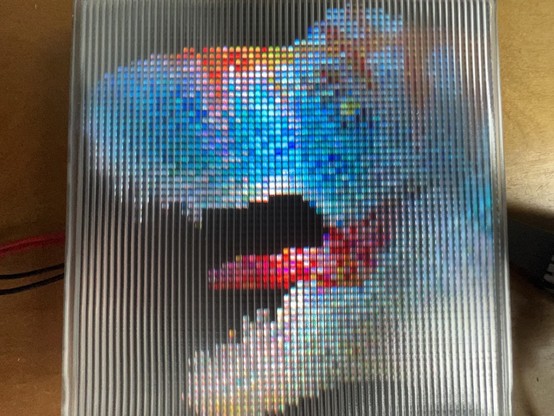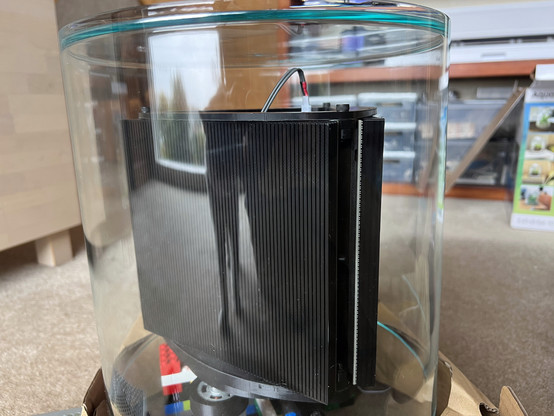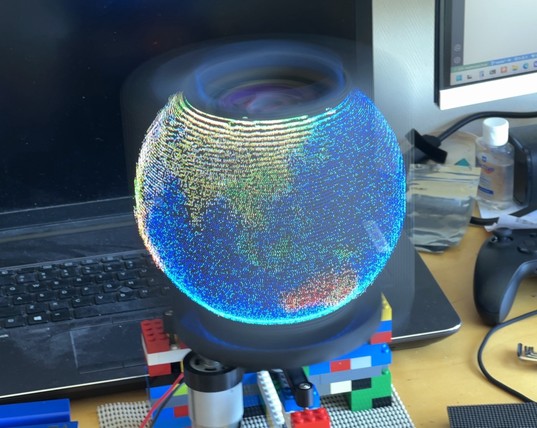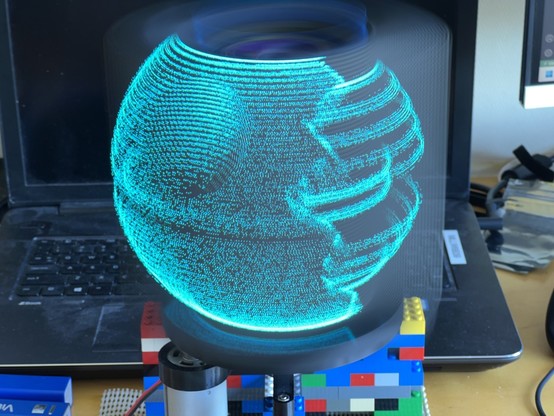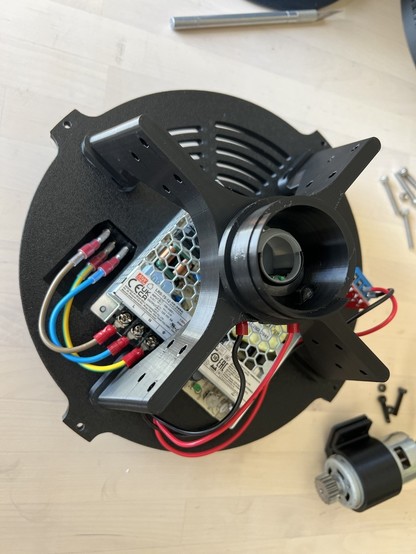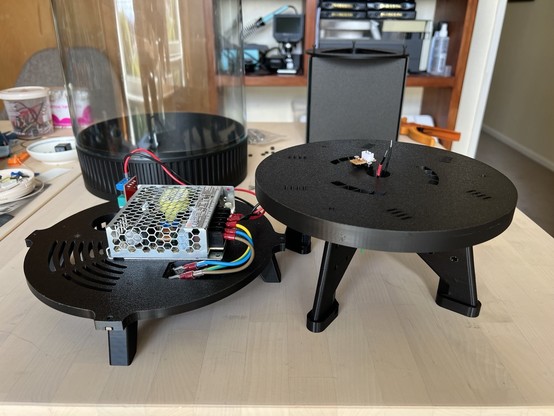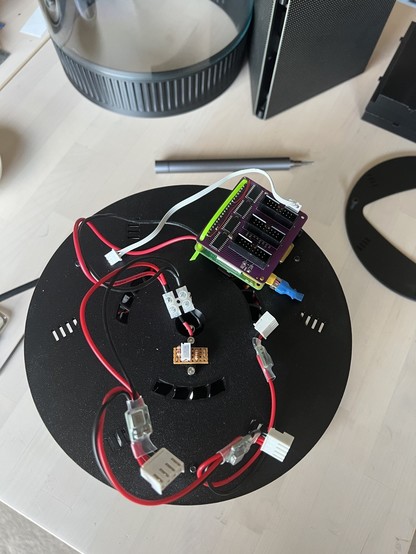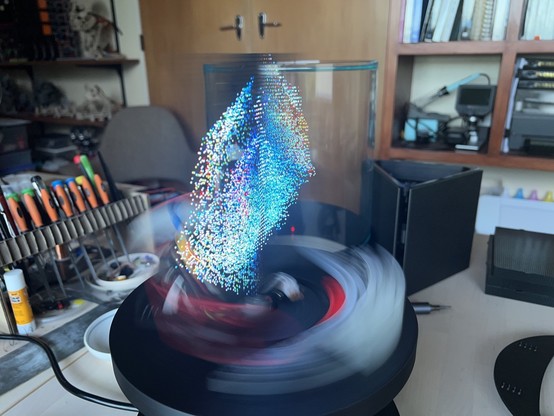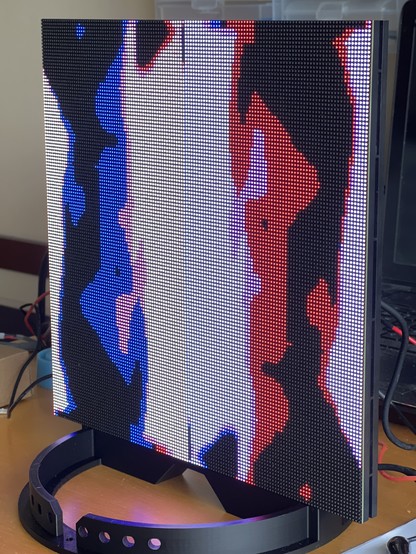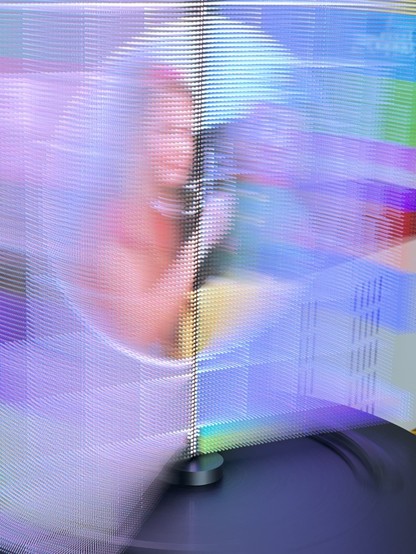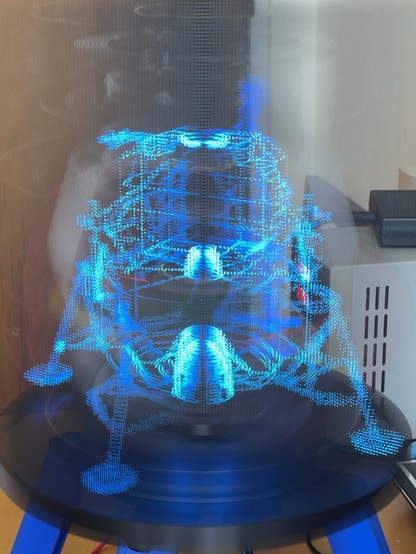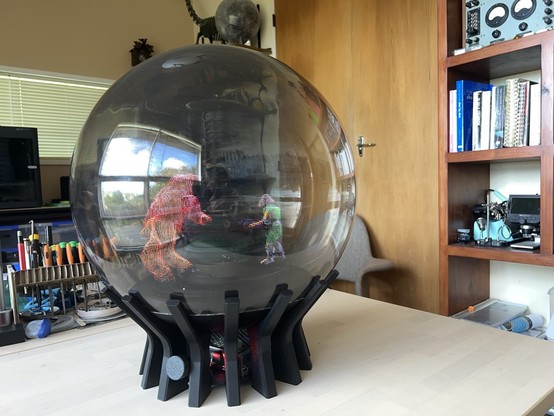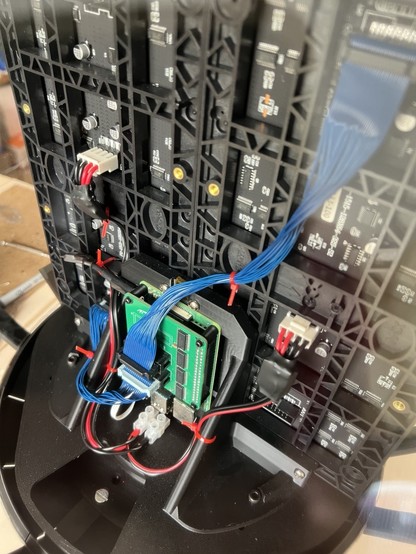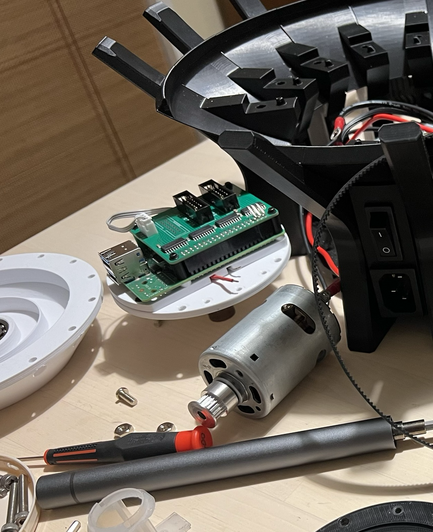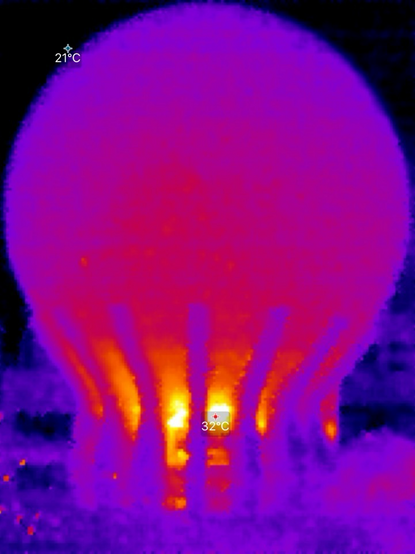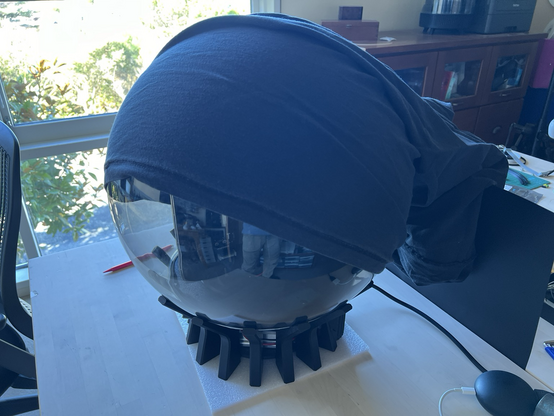Well I got a lens out of it in the end. It does make it more directional, but there’s more light off axis than I need.
I went back to the slats, and finally got all the bits hooked up together.
It sort of works?
You can see what's going on a bit more clearly with a simpler shape. It looks better when you can use both eyes on it!
The depth is smeared more than I want because the collimators are too shallow (because I don't like prints that take more than 16 hours to complete). I want to make them tighter, and spin the whole thing faster to compensate.
The nice thing about these LED panels is that they're very high framerate (and cheap!). I'm updating these at 1.5 KHz - with 3 of them in a ring, that's 4.5 KHz. Just driven in software from a (somewhat dizzy) Raspberry Pi.
Just realised that I can increase the resolution by progressively offsetting each panel by 1/3 the LED pitch.
That should contain or possibly create any shrapnel.
Making parts for this has been a real saga, so while I wait for a faster printer to arrive I tried removing the collimators and running it as a swept volume display. Now I’m thinking maybe that’s what I should have built in the first place.
The thing I've been trying to make creates its 3D effect by displaying a whole different view in every direction, which means it can handle occlusion and fancy lighting at the cost of vertical parallax.
To turn that setup into a swept volume (where it's lighting up the LEDs according to where they are in space - full 3D, but glowy and transparent) I keep everything but the collimators, and just render each view with the near & far clip planes set really close together.
I'll probably make two displays now - finish off the autostereoscopic one, but then rearrange the geometry so that I can sweep through more than just a thickish-walled cylinder.
A quirk of these LED matrix panels is that they simultaneously update two rows at once, separated by half the panel. So on a 64x64 panel, you update rows 0 & 32, 1 & 33, 2 & 34 etc.
However, if you want to sweep one around an axis, you ideally want to update the outer LEDs at a faster rate than the inner ones, and this layout prevents that.
The Ring of Power from Harry Potter.
I’ve mentally moved on from this design, but I went ahead and built it to the point I can call it finished.
The advantages of this approach - occlusion and view-dependent lighting - are undermined by the fact that too much of the colour depth is sacrificed to hitting the necessary framerate. The sort of simple scenes it can display could be displayed better by a swept volume.
Most of the time we don't move our heads up and down very much, so the lack of vertical parallax seemed like it wouldn't be a big limitation. But one of the situations where we do move our heads quite a lot is when presented with a neat little 3D effect sitting on a desk.
Anyway, the new display is going to be amazing.
I even remembered to take some pictures before I put it all together.
Scouring Aliexpress for LED panels for the new display, and it seems the higher resolution ones tend to be flexible. I spent a while investigating developable surfaces* to see how I could take advantage of this, but couldn't come up with a layout that offers any advantages over a flat square centred on the axis. Seems disappointingly pedestrian.
(*Twisting a sheet of paper in my hands)
I'm arranging it as two rectangular panels arranged with their bottom edges touching on the axis, which lets me update columns at the same radius simultaneously. The outer columns need to be updated more frequently than the inner columns, and one of the nice things about these LED panels is that you choose your own update strategy - you're not stuck with scanning a whole frame each time.
If the lines were completely independent, you could evenly scan a sector with half the number of line updates compared to updating the whole frame. As it is, each line has to be updated in parallel with one that's half a panel further down, so it ends up taking 3/4 of the line updates instead (because some updates have to update the outer line while scanning out black to the inner line).
Display 1 currently serving as convenient rotating testbed.
The thing about voxels is that even when they’re not working, they look cool.
New display, new panels. I'm driving these ones using DPI on a Raspberry Pi, which is a handy way of wiggling 24 GPIO lines with precise timing and no CPU involvement.
The results I was getting with the new display were so much better than the original that I went back for another pass at it. Turns out there were a couple of stupid bugs limiting the refresh rate. The colour depth is now vastly improved.
This is still using software bit banging. I'm going to switch it to using DPI, but the current interface board wasn't designed with that in mind, and the GPIO mapping doesn't put all 3 displays on valid DPI pins.
If you squizz your eyes at this, you can see the 3D.
If you have difficulty converging it, it helps to make the image really small and gradually enlarge it once your eyes have locked on.
I had the opportunity to give some live demos of this thing recently. It went over well, but the noise was a real killer.
I've reworked it to use a belt drive instead of the horrible 3D printed gear - before, it screamed; now it whirrs.
The new platform now has enough bits to display an image while spinning.
I massively overestimated how much lead would be needed to counterbalance the small amount of slightly off-axis electronics.
Slowly turning up the dial at arm’s length.
It would be convenient to address the voxel data as a stack of horizontal slices, because that's how it's exported from lots of existing tools. I have to rotate it 90 degrees though, because scanning out is faster if each column's data can be addressed as consecutive bytes.
It's a small change, but there's a 6.5x difference in speed between the two orientations, which directly translates into voxel density in the final output.
I really need to get a hobby where missing my framerate target doesn't make me physically nauseous.
I am having so much fun with this thing.
I've implemented parts of a content pipeline for rendering a scene on the PC and streaming it to this display, but writing video streaming code is so much less fun than playing with voxels that it may take a while to finish.
Here, I've stored the animation uncompressed on the display itself, and am updating it as fast as the Pi's SD card can handle. (Not very fast.)
My target for this display is 600 rpm - lower than that and it's too flickery; higher than that and I can't refresh fast enough to get 400 voxels around the circumference without dropping to 1 bpc. I'm nudging 400 rpm here, and it's still pretty unfilmable and absolutely terrifying to be close to. I have to decide whether the overall approach is worthwhile enough to start spending money on aluminium and polycarbonate.
Slightly higher rpm, slightly longer shutter.
The other problem I have is that to sell the 3D effect I need to move the camera around a lot, so I'm going to have to put some effort into building a studio backdrop.

